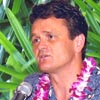Pacific Southwest, Region 9
Serving: Arizona, California, Hawaii, Nevada, Pacific Islands, Tribal Nations
Pacific regional workshop on coral reefs
and land-based pollution
Note: EPA no longer updates this information, but it may be useful as a reference or resource.
The notes on this page were compiled by EPA staff who attended the 2003 Pacific regional workshop. Photos by Larry Debord. June 24, 2003

Welcome and Overview
Wayne Nastri,Regional Administrator, EPA Region 9
EPA staff notes: Ninety-five percent of all US coral reefs are within jurisdiction of U.S. Environmental Protection Agency (EPA) Region 9. EPA awarded $1.3M in grants last year to partner agencies in Region 9 to protect coral reefs. For example, the Hanalei Watershed Initiative received $700K to upgrade inadequate cesspools, implement best management practices for taro, and monitor aquatic life in the river and nearby coral reefs. EPA’s goal is to minimize adverse impacts of pollution.

Regional Administrator, EPA Region 10
EPA staff notes: He recognized the similarities between the Northwest and Pacific Islands. He seeks to share tools and approaches. A partnership approach between federal, state, local governments, local communities, and tribal members is needed for effective policy that fits the on the ground conditions.

Hawaii State Conservationist, NRCS
EPA staff notes: The Natural Resources Conservation Service (NRCS) promotes conservation on private lands and provides technical assistance and financial incentive programs to private land owners. The traditional Hawaiian ahupua’a land management system is a good example of effective land stewardship.
Keynote Address: Impacts of Pollutants on Pacific Coral Reefs

Professor, University of Guam Marine Laboratory
EPA staff notes: Science involves the art of communication. It is only useful when you apply it through management and policy and get stakeholder buy-in. We need to manage human activities not biological systems and this occurs best when we “listen to the animals” (the coral reefs).
Persistence and perpetuation of coral reefs depends upon possible LBF coral reproduction and recruitment. Without the ability to recruit, reproduction is useless and many coral reefs are not currently able to recruit. Decreased salinity from freshwater runoff, heavy metals and fertilizers from road runoff, oil spills, organophosphates from golf-course fertilization, and algal overgrowth can cause reproductive and recruitment failure in coral reefs. Natural disturbances are a natural part of coral reef ecology providing opportunities for less-competitive coral species to compete for space, thereby increasing diversity. However, human-caused stresses affect coral health and decrease the ability of reefs to recover from natural disturbances.
Managers and stakeholders need to ask relevant questions when evaluating scientific findings and better integrate watershed management by partnering marine interests with land-based partners. The following key management issues need to be addressed:
- look at environmental harm and determine cost-to-benefit ratio;
- ask what is the cost if one is careful about doing something versus the cost if one makes a mistake;
- realize that small sample sizes will show little to no effects; and
- recognize if data or techniques were omitted.
Panel Discussion: Action Strategies to Reduce Impacts to Land-based Pollution (LBP)
Panel members were asked to address the following questions:- What key actions are needed to reduce LBP?
- What types of sources/pollutants should we focus on?
- Where do we need to develop new approaches?
Hawaii:
Katina Henderson,
Water Quality Management Planner, Department
of Health (DOH)
EPA staff notes: The goal for Hawaii’s local action strategy (LAS) is to help reduce land-based pollution (LBP) contributions to coral reef degradation. Deliverables include a framework document to help guide the State process for LAS and produce a list of priority ahupua’a. Short-term and long-term measures of success are identified in the process.
Key actions to reduce LBP impacts on coral reefs include identifying and implementing projects on land to reduce entrance of pollutants into waters. Pollutants of concern include sediment, nutrients, temperature, and toxics. Sources of pollutants are wastewater, storm water, surface water runoff, and groundwater seepage. New approaches for reducing LBP impacts are needed where background levels of pollution are high, where there is a weak link between LBP and coral reef degradation, and where there is low stakeholder involvement.
Guam:
Dave Limtiaco,
Department of Agriculture Division of Forestry
and Soil Resources, and
Jacqueline Flores, Natural Resources Conservation
Service (NRCS)
EPA staff notes: Impacts and issues include: increased sedimentation, lack of adequate enforcement, lack of public support and participation, and lack of adequate planning. Key study areas include Fouha and Ugum watersheds, 2 of the 19 watersheds in Guam. Two specific goals for the LAS are to improve water quality for drinking water and coral propagation and recruitment. Strategies likely to resolve impacts include implementing and enforcing existing regulations and changing stakeholder behavior.
American Samoa (AS):
Mary Midkiff,
AS Costal Management Program
EPA staff notes: Much of land-based pollution (LBP) in American Samoa is attributed to the 35% increase in population on a 15-mile-long island. In addition, unmanaged land use is a source of pollution as land use changes from a communal-style of living to western-type development. Goal of the LAS process is to protect coral reefs from LBP. Objectives include implementation of the Nonpoint Source Pollution (NPS) Program Plan, monitoring parameters of coral health and water quality, and promoting education and outreach programs.
Types of pollutants include nutrients, sediment (from new development projects), and pathogens. Key actions to reduce LBP include implementation and coordination of NPS program; implementation of a community-based fisheries management program; revision of environmental regulations and enforcement of laws; and increasing community awareness and education. New approaches include identifying gaps in the NPS program; enforcing laws and imposing fines; establishing island-specific better management practices focusing on low cost and maintenance alternatives; and providing incentives for better management practices implemented at the community level.
Commonwealth of
Northern Marianas Islands (CNMI): Erica Cochrane,
Coastal Resources Management
EPA staff notes: Approximately 90,000 people live in the three southern-most of CNMI’s 14 islands: Saipan, Tinian, and Rota. Ninety percent of the CNMI population lives on Saipan. Coral reefs provide tourism, cultural resources, food, protection from storms and waves, beauty, biological diversity, and scientific study. Threats to CNMI reefs include land-based and marine sources of pollution, destructive fish practices, recreational-use damage, and limited involvement in natural resource protection. With 18 language groups in CNMI, community education is difficult. The following five watersheds were chosen for the development of CNMI’s Local Action Strategy: Takpochau and Laulau on the island of Saipan; Makpo on the island of Tinian; and Song Song and Talakaya on the island of Rota.
Panel Discussion: Indicators of land-based pollution effects on coral reefs
Using Coral Reefs as Indicators of Land-based Pollution
Peter Houk,Division of Environmental Quality (DEQ), CNMI
EPA staff notes: Presented a document titled: “Bibliography to Assist Monitoring and Understanding the Effects of Land-Based Sources of Pollution”. He wanted to expand this bibliography and request that additional citations be sent to Peter Houk at deq.biologist@saipan.com. He presented a brief synopsis of published studies that have successfully documented how LBP alters reef communities. He discussed sources of LBP; effects on benthos; quantifying extent of river discharge; and understanding urban runoff. In addition, he presented details on the CNMI monitoring program; selection of sites, methods, and results. Studies must be statistically rigorous and monitor both relative abundance and biodiversity in coral reefs.
Impacts of Land-derived Sediments on Hawaiian Coral Reefs
Paul Jokiel,University of Hawaii, Hawaii Institue of Marine Biology
EPA staff notes: Feral goats and axis deer, among other animals, are a major cause of land erosion and sedimentation on Hawaii’s reefs. These animals eat plants down to their roots leaving barren lands, which quickly erode. After eradication of feral goats from Kahoolawe, coral reefs were uncovered by wave events, thereby increasing coral recruitment. Permitted and non-permitted grading by landowners in Pila`a, Kauai resulted in major mudflows during heavy rains. Pollutants most useful to monitor are HUMANS.
Water Quality Problems in the Florida Keys: Sources and Solutions
Bill Kruczynski,EPA Region 4
EPA staff notes: The south Florida ecosystem is an area of 18,000 square miles with a population of 6 million people. Barrier reefs in Florida Keys are dying. The link between LBP and degradation of the barrier reefs is weak. There is evidence, however, of LBP affecting near-shore water quality and coral reef communities and it is believed that changes to community structure in the near-shore reefs may cascade to off-shore reefs. Septic tanks, cesspools, and shallow injection wells contribute nutrients which result in poor water quality in canals within residential area and living infectious viruses (e.g. hepatitis B and polio) and bacteria. Central wastewater collection and treatment systems are the most cost effective and environmentally safe alternative for most of Florida’s service areas.
Long-term monitoring has documented the continuing loss of coral resources. Monitoring must continue to track changes, but additional resources are required to fund cause-and-effect research to find the causes of coral decline. He stressed that we do not need all the answers before we can take action.
Water Quality Management for Marine Protected Areas

Great Barrier Reef Marine Park Authority
EPA staff notes: The Great Barrier Reef (GBR) “catchment” (Australian word for watershed) is the primary source of pollutants to the GBR Sediment, nitrogen, and phosphorous are major pollutants from cattle grazing and fertilized agriculture. These pollutants can directly affect coral and inhibit coral recovery after disturbance, especially recruitment. Factors important for water quality management of the GBR include socio-economic factors, science and research, legislation, and international and national obligations. The Reef Water Quality Protection Plan has broad governmental support, including support from the Prime Minister and the Premier of Queensland. The main message of this plan is, “the connection between land and sea is recognized in broad scale planning and policy processes and is understood by the community at the local level.”
Panel Discussion: Success Stories
Watershed Restoration and Reforestation on Guam
Dave Limtiaco,Guam
EPA staff notes: Fires, both wildfires and arson fires, are a major problem in Guam. A 3-acre arson fire can produce 30 tons of silt runoff. This produces “badlands” with no vegetation. Guam is implementing a revegetation mosaic strategy, which stabilizes the badlands, establishes buffers of native trees, and weeds out invasive plants. Cooperative Fire Protection develops green belts which cut down on acreage that can burn. Forest Stewardship works with private landowners. Urban and Community Forest Project educates and involves the community on the effects of storm-water runoff on coral reefs.
American Samoa’s Non-Point Source Pollution Program

EPA, American Samoa
EPA staff notes: American Samoa was one of the first states and territories to get its Non-Point Source Plan approval. They have learned from failures. For example, a stream-bank revegetation effort was destroyed by a 20-year flood event, and they have worked through logistical problems to improve used oil collection program. The fractured bedrock and high percolation rate allows for pollutants to quickly travel from surface water, to groundwater to the coral reefs. Piggeries are a major source of LBP on American Samoa and the required 50-foot setback from a stream is required but not enforced. American Samoa wants to use the LAS to fill data gaps within the Non-Point Source program.
Outreach in the CNMI

Division of Environmental Quality (DEQ), CNMI
EPA staff notes: Visit http://www.deq.gov.mp ![]() for
more on CNMI’s coral reef outreach. Types
of outreach include an Environmental Symposium and Exhibit Fair, awareness
campaigns, an environmental video series, school presentations,
and school brochures. These
methods have proven to be effective but need to continue. She showed an informative
video about nonpoint source pollution, water quality, and reefs produced by
CNMI and aired on local television.
for
more on CNMI’s coral reef outreach. Types
of outreach include an Environmental Symposium and Exhibit Fair, awareness
campaigns, an environmental video series, school presentations,
and school brochures. These
methods have proven to be effective but need to continue. She showed an informative
video about nonpoint source pollution, water quality, and reefs produced by
CNMI and aired on local television.
Panel Discussion: Tools for understanding and managing pollutant inputs
Panel members were asked to address the following questions:
- What existing tools are useful in managing LBP?
- What tools are deserving of further development?
Tools to Determine Terrestrial Fluxes to Coastal Waters
Gordon Tribble,U.S. Geological Survey (USGS), Honolulu, HI
EPA staff notes: Erosion and sediment transport: Embayments typically have the best developed coral reefs, however, streams commonly discharge into these embayments making them more susceptible to LBP. Ways to measure sediment flux include gauge methods, plot methods, and models. Goals and products of the watershed vision include: developing GIS-based models of watershed response to ecosystem changes; provide decision support system tools; measure watershed restoration on marine communities; show how types of ecosystem disturbances contribute to coastal loadings; and promote economic and biologic sustainability. Lessons learned about land use changes include: it will happen; there will be impacts, largely irreversible; and they can mitigate with knowledge and planning.
Upland Conservation Practices to Protect Our Coral Reef Resources
Jacqueline Flores,NRCS, Guam
EPA staff notes: NRCS staff develop holistic conservation plans that address “SWAPA + H”:
- Soil - a limited resource
- Water – clean surface water and groundwater
- Air – clean and odor free
- Plants – great diversity
- Animals – domestic and wildlife
- Humans – economic social, cultural
NRCS supports locally led resource conservation in 5 areas:
- animal manure management systems;
- agronomic cropping systems;
- engineering design and installation;
- tropical plant material recommendations; and
- watershed planning and resource
assessments.
Group Discussion: Land-Based Pollution Action Plans: Funding Opportunities
Jonathan Kelsey,
National Oceanic and Atmospheric Administration
(NOAA)
EPA staff notes:
Access the Coral Reef Conservation Act of 2000 at http://www.coralreef.noaa.gov ![]()
For info on NOAA’s grants see http://www.ofa.noaa.gov/~amd/SOLINDEX.HTML ![]()
NOAA has the following programs: Coral Reef Conservation Program, National Fish
and Wildlife Foundation, §6217 Coastal Nonpoint Pollution Control Program.
Wendy Wiltse and John McCarroll EPA
EPA staff notes: In the last two years, EPA has awarded $1.3M in grants to protect coral reefs in Hawaii. EPA has the following grants: State/Tribal/Local government’s Wetlands Protection Grants (coral reefs are classified as wetlands under Clean Water Act Programs), Resource Conservation Funds, Environmental Education, Integrated Pest Management Grants, Water Quality Cooperative Agreements, Watershed Initiative, STAR Grants for research, and Pacific Islands Consolidated Grants for many uses. Visit https://www.epa.gov/ebtpages/econgrants.html for more information on relevant grants.
Chris Smith, NRCS
EPA staff notes: NRCS works with private landowners on a volunteer basis to implement Farm Bill programs. Any corporation or member of a corporation that exceeds $2.5M in adjusted gross income is ineligible under the Farm Bill unless 75% of the assets are agriculture. This poses a problem in Hawaii where millions of acres are owned by estates.
The NRCS has the following programs: EQIP Environmental Quality Incentives
Program, WHIP Wildlife Habitats Incentives Program, WRP Wetlands Reserve Program,
CSP Conservation Security Program (requires maintaining conservation practices
on working lands), RC&D Resource Conservation and Development. Visit http://www.nrcs.usda.gov ![]() .
.
Discussion: Land-Based Pollution Action Plans
What are the common needs?
EPA staff notes: Adequate enforcement of current environmental laws emerged as the greatest need among all islands. Additionally, monitoring tools for assessing pollutants and trigger levels for regulating sediment were identified as a common need. The islands also stressed that the capacity of their local governments needed to be increased in order to adequately manage environmental issues. As part of this capacity building, decreasing turnover in technical staff was identified as an important goal. They also emphasized the importance of improving outreach and education to the diverse ethnic groups living on the islands.
Additional resources:
- Agenda (PDF) (6 pp, 235K, About PDF)
- Pacific land-based pollution workshop
- Field Trips
- Environmental awards
- Hawaii (press release 4/21/03)
- Pacific Islands (press release 4/21/03)
